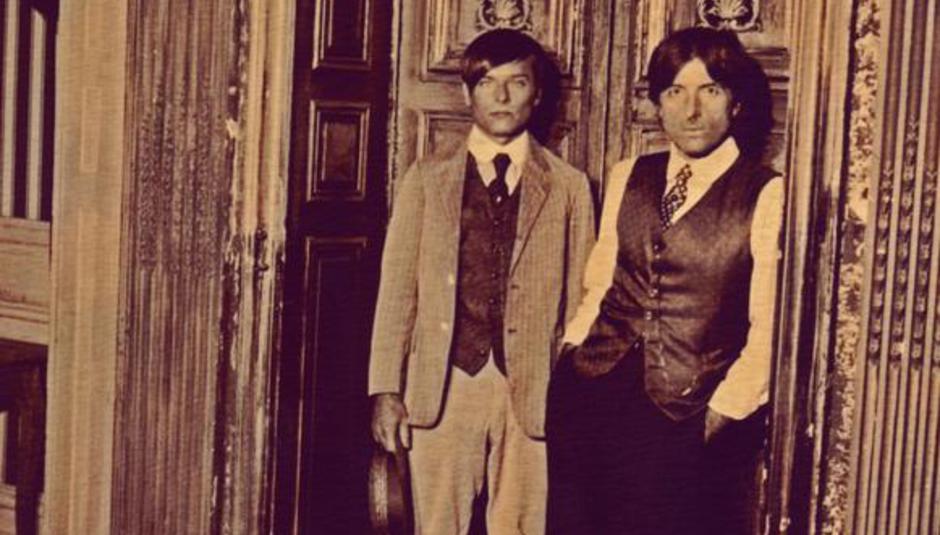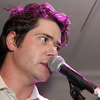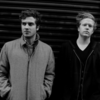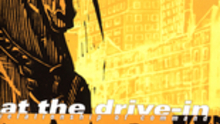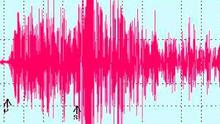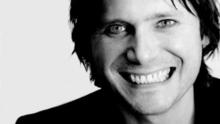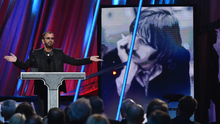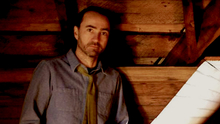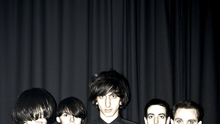Back in 1902, cinema was still a relatively new concept. It was, after all, only seven years since Auguste and Louis Lumière had pioneered motion pictures with L'arrivée d'un train en gare de La Ciotat: the moving image of a train pulling into a station which, apocryphally, sent cinema goers into a mass panic. Nevertheless, it was in 1902 that Georges Méliès first released Le Voyage dans la Lune and thus became arguably the first auteur to not only include then state-of-the-art special effects in one of his films, but also the pioneer of science fiction in the movies. The George Lucas of his day, Méliès has been inextricably associated with cinematic space exploration for 110 years and it could easily be argued that Air are his sonic counterparts.
Originally released in both black & white and in colour, the prints of the film were painstakingly hand painted. Lost for years, the colour print was finally rediscovered in Spain in 1993 and, six years later, work began on restoring the badly damaged film reels. With a view to premiering the rescued version at the 2011 Cannes film festival, Fondation Groupama Gan and Fondation Technicolor, the two cinematic organisations working in film preservation, approached Air earlier this year with a view to producing a new soundtrack.
Jean-Benoit Dunckel and Nicolas Godin kindly took some time to talk to DiS about the project and its expansion into a full-length LP, and we started by discussing whether it was Le Voyage dans la Lune’s stature in French art that drew them to the project, or was the attraction more borne of a passion for cinema....?
AIR: It’s more like, when you make a record you know you need a strong idea behind it, and when something like [this project] happens, you just jump on it. Otherwise you just make a collection of songs that have nothing to do with one another, so it’s good to have something melting the thing together.
But, well, we are big fans of cinema in general, and we knew [of] Georges Méliès before, because this part of the movie, with the starship hitting the eye of the moon is such an icon, and so well known. And also Méliès has been so influential for cinema in general, for example I know that Scorcese is a big fan of him [Méliès’ films are a central part of Scorcese’s new film Hugo] and Spielberg, and Star Wars have been influenced by him. He has invented science fiction, he has invented special effects, so to be able to play with images like that, we couldn’t not do it. And there was the exposure: the festival at Cannes is so big, we couldn’t refuse.”
Although the first known public exhibition of a film with sound took place in Paris two years prior to the release of Le Voyage dans la Lune, it wasn’t until 1923 that a set of shorts shown in New York became the first commercial display of “talkies”. Instead, Méliès’ films were always intended to be narrated live in the theatre. This makes Air’s effort the first official score the film has ever seen. Presumably this would have to act as a stand-in for that narration?
AIR: Yes. And there was a problem with the first scene, because this was where the narrator was explaining the whole thing, so on the screen nothing really exciting is happening and it was hard for us to replace the narrator with the music, so that was a big challenge for us. But after that there is so much action in the movie that the fact that the narrator disappears is not a problem. But it was that first four minutes, because we didn’t want to use any dialogue, but we put in some layers upon layers, and at some point in the end there was some cohesion. But everything in the movie was OK except that.
It’s interesting that Godin mentions the opening scene as difficult. It’s a four-minute, single-shot expository scene with very little action as the French scientists devise their ideas for the voyage and subsequently build the rocket, almost entirely lacking in drama. Despite this, the soundtrack opens with ‘Astronomic Club’ and ‘Seven Stars’: two of the more ominous, tense tracks in Air’s canon. So what was the thinking behind having the record’s more dramatic moments here rather than juxtaposed with the narrative’s apex?
AIR: They were in this big... I don’t know, church? This big room, so we wanted to use something with a lot of beats and a lot of reverb so you can feel the space. And, if you notice, on the movie there’s the big drum with all the reverb, but on the record there’s no reverb; because you don’t have the image you don’t need the space anymore. So you don’t have anything happening, but there was this big space, like a cathedral, or Harry Potter, so this is what kind of music we can do.
Of course it would be easy just to say that the soundtrack is a substitute for narration, but there are a number of different schools of thought on what the meaning of the film is. Is it the simplest narrative used to showcase Méliès’ array of technical accomplishments? Or is it more allegorical than that, with the Freudian imagery of a phallic rocket hitting the moon in the eye, or the spationautes’ being celebrated for false tales of bravery? And how was this conveyed?
AIR: I think it’s pure entertainment, but I think that when you know Georges Méliès, you know that each detail has a story behind it. For example each character has an umbrella, which is linked to the stories of Jules Verne and H.G. Wells. And then the starship, it is almost looking like a weapon, and the image of that hitting the moon and damaging the moon is important, because we are really damaging nature, and Méliès really had that in mind. We arrive, we kill everything and we fight, and I think that’s a good analogy for what Europe was doing in 1902 in Africa.
I think [the music conveys] that it’s kind of sad; when the rocket hits the moon I see it as a kind of sad experience. It’s the end of innocence, like the conquistadors when they arrived in South America they brought all the germs and they destroyed all the people and civilisations everywhere. [In the film] what they do with this alien, it’s horrible, the first thing they do is just hit them with the umbrella [in the film, this vanquishes the hapless aliens]. There’s no talking, no communication. It’s pretty raw and violent.
The soundtrack is perhaps not quite what we’ve come to expect from the electropop duo. Much like the film and its visual effects it is very organic and, if not simple, there is something more rudimentary about it than anything in their back catalogue. I asked whether this was difficult to expand into a full-length album, and how they approached this....
AIR: No, it’s more that we were frustrated when we finished the movie, because it was too short. It was like a relief, like ‘cool, we can take this further’. I think the album length is a good length for a journey for the listener; that’s what we grew up with, so we know how to tell a story. Longer or shorter is more challenging for us, but the length of an album is perfect for us to tell a story, to take someone by the hand and let it go at the end of the music.
There were two processes [when it came to recording]. The film process, the 14 minutes, we had a deadline of what, three weeks, and then the album was like a classic album, we didn’t have any pressure and could take more time. We wanted to have the perfect music for the perfect scene, and then there were some tracks where we could go a bit longer so that was easy. And we had some produced tracks we added on the album at the end. It’s a photo of what we had in mind, musically, at this time.
Not that this is by any means Air’s first foray into film soundtracks. Their music has been used most notably by Sofia Coppola; as well as contributing to The Virgin Suicides and Lost in Translation they composed the soundtrack to Marie Antoinette in 2006. Of course, Le Voyage dans la Lune is almost unrecognisably removed from such contemporary cinema. Did this require a change of approach?
AIR: This is more like a pop album, a collection of songs; on the movie with Sofia Coppola it’s more like you compose one thing and you arrange it differently, like a classic film score. With a silent movie you cannot do that, because there’s too much that repeats and it’s boring after a while.
Now I’m not sure about something here. For me the Marie Antoinette soundtrack was far more like the pop music we’re accustomed to from Air; far more accessible and breezy than this often dark record. In keeping with Coppola’s decision to use contemporary pop music in a period piece, I suggest that the earlier piece was far closer to a traditional pop album.
AIR: Nowadays I think, with the likes of Marie Antoinette there’s a music supervisor who selects different tracks for each scene. There’s not the work of a composer, the job has changed – there’s no more John Barry or Ennio Morricone.
It’s a bit more risky, maybe. We don’t even know what to expect concerning the results; we didn’t know if the match would work between contemporary music and old images like that. There’s a risk it’s going to be distasteful and cheesy.
We wanted to respect the way Georges Méliès was working. There are lots of home-made sounds... and the vocals, it’s like when you read the comics, they’re not words really, it’s more like sounds. We also used animal sounds to make the people speak, because we didn’t want to use any dialogue but we still wanted to have organic sounds that express feeling.”
As I alluded to earlier, this is hardly a new theme for Air to visit. Through its title alone, not to mention subject matter, Le Voyage dans la Lune is sure to attract comparisons to their magnificent 1998 debut Moon Safari. Surely they must have been conscious of this when making the record, but was it something they were keen to avoid?
AIR: Yeah, I said to myself, ‘The moon, again? What are we going to do again with that?’ It’s two musical pieces coming from the science fiction culture at the beginning of a century. The world I live in has been inspired by H.G. Wells and Jules Verne, and then Moon Safari has been influenced by Ray Bradbury’s The Chronicles of Mars. So it’s always the same story, the two pieces of music have been inspired by all of science fiction, those wrong visions of the future. It shows you how wrong we are right now about the future and about our choices.
But we have been raised like that, and it’s a kind of disillusion. We are from this generation where they lied to us; they told us when we’re 30 years old we’ll be living in a space colony on some other planet, and it didn’t happen. When I was a child everybody was talking about the year 2000, a future that will happen... and nothing really happened except the iPad. It’s sad for our generation.
Listening the album, it’s clear that Air’s musical influences have shifted away from the European pop and dance of their earlier work. Instead the likes of ‘Parade’ with its aggressive guitar line and the heavy bass of ‘Sonic Armada’ sound almost as if they’re an alternative take on 1960s Anglo-American rock music; the likes of ‘Moon Fever’ one of the few songs with what you might call the classic Air sound. What was the musical inspiration here, and what were they listening to around the time of recording?
AIR: The colour version [of the film] reminds me of London in the 60s, it’s like the cover of Sgt. Pepper, so I think a lot of the music has been inspired by this era; it was the mood we were in, what we felt when we were watching the movie.
At the time we were listening to a lot of new things and a lot of classical music... a lot of new bands. There’s some good guitar lines, and we were listening to Ariel Pink, but it’s a soundtrack, it’s not pop. We had the chance to do something pop, with normal songs and verse-chorus, but we wanted to do something very psychedelic. And we really like Victoria Legrande [of Beach House, who lends vocals to the album]; this is one of the best recent albums, and her voice is so original. We really wanted something raw and mineral, and I don’t know any other singer who could have done that really.
We have this studio now, and this studio has so many keyboards, so there were so many possibilities we wanted to use. The challenge was to get a very fat, rich sound playing around with the microphones and the drums that we had, kind of like American hip-hop with our own taste.
With such an organic yet dense and multi-layered record as this, I begin to fear that my romantic dreams of seeing the soundtrack performed as a live accompaniment to a screening of the film, as was the old tradition in theaters, may have remain just that. Sadly it seems I was right, but the temptation must have been there?
AIR: Yes... not now. But we could seriously consider that, with something else, because it’s not complicated; it’s a silent movie for 14 minutes you could just play along to.
No, there are no plans for live performances, or touring. It’s too complicated with the movie, and we toured last year, and lost one year, so I think we need to pause now because the audience have seen us already. We need to write something new, not a soundtrack, but something with songs. A new side of Air.
Le Voyage Dans La Lune is released on February 6.

